How To Make An Authentic Breakthrough in Digital
Intro: The Statistics
1. Create a Theme
2. Make it Fun
3. Tell a Story
Summary: Lessons Learned
Consider these two stats from a joint study by Crowdtap and Ipsos Media CT, as quoted in AdWeek:
- User Generated Content is trusted 50% more than any other media.
- User Generated Content is 35% more memorable.
These facts probably just confirm what you already knew instinctively; that the most authentic, trusted content for any audience is the freely expressed input from their peers (often referred to as User Generated Content, or UGC).
As a digitally-savvy mid-size marketer, then, the next two statistics will either make you cringe… or celebrate.
- In a Pardot Research Report, 80% of respondents said "authenticity of content" was the most influential factor in deciding to follow a brand.
- By contrast, a LinkedIn Report sponsored by four leading technology organizations found that only 22% of the companies they surveyed "encourage user generated content."
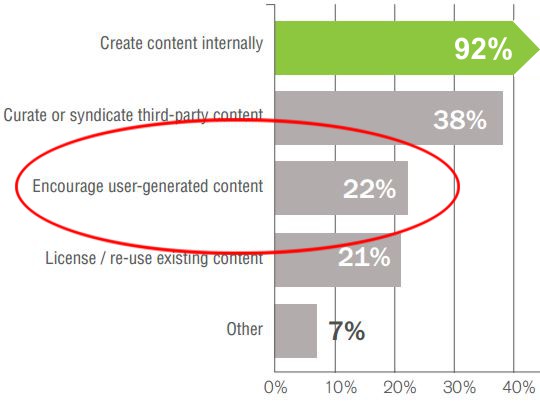 Excerpt from LinkedIn Content Marketing Report.
Excerpt from LinkedIn Content Marketing Report.If you're already featuring user content on your website, that's reason to celebrate! But I expect many of you see yourselves on the wrong side of that second statistic, because as mid-size marketers you may believe that only the biggest or trendiest brands can build an online community active enough to generate authentic user content.
It's a wide-open field for you to score breakthrough points with your customers and clients.
That leaves you locked out of the 22% club. It's just another chance for the major brands you compete against to grab the lion's share of audience engagement, right?
Wrong. It's an opportunity mid-size marketers like yourselves should celebrate.
If only 22% of your fellow marketers are even making an effort to encourage this powerful content, it's a wide-open field for you to score breakthrough points with your customers and clients.
Read on and I'll give you three ways you—and your community—can start jumping for joy.
1. Create a Theme
One reason marketers might hold back on encouraging user content is that An award-winning GoPro user video.
An award-winning GoPro user video.
they don't feel their product or service is exciting enough. It's one thing for Go Pro, the wearable camera company, to have people upload thrilling videos of their latest extreme adventure. But if your product is a standard packaged good, you may feel selfies of users posing with it in odd locations will only go so far. And you're probably right.
What you have to do is think outside the box: develop a theme around your product that's compelling enough to make your audience want to jump in.
One example of this strategy that has resulted in a great outpouring of user generated content is the Canadian online community of Benzagel® acne care products. A large portion of the Benzagel website is devoted to its "Community Pages," which focus on the theme of reducing stress to avoid acne breakouts.
Benzagel has clearly recognized that what their customers really want is to feel good Benzagel hosts an active community on its own website.
Benzagel hosts an active community on its own website.
about themselves and how they look to their peers. So Benzagel built a very active community around the feel-good theme of how to come to terms with life's stressful moments.
Benzagel has found many unique ways to express this theme. One of the best has been the "Be A Maker" campaign, in which users were asked to "Show our Benzagel Community how you relieve stress through self expression."
It was a brilliant invitation for community members to "share what you love to make with the broader Benzagel Community," which offered the dual benefit of providing online exposure for the most creative community members, and a stream of inspirational content for visitors to the website.
My personal favourite of the many submissions posted is a poem titled "Things I Like" by Anna L., an evocative composition with a lilting cadence and uplifting message.  "Things I like… "
"Things I like… "
It's just one example of the high quality and range of creative expression exhibited throughout the campaign.
Contributions to Be A Maker were entered through an online submission form, which means they were not posted automatically, but, as the form says, "on merit". This avoids another hesitation many marketers have about user content: the issue of controlling the content that appears on your site. It's actually okay to exercise control over your content. When posting is conditional, it's an honour to be chosen. And you can bet the chosen contributors will share the posting among their own extensive networks, thereby drawing more traffic to your website.
Another big bonus of the Benzagel Be A Maker campaign is that the content provided by users continued to reside on the website itself. In other words, it is "owned media," as opposed to content that resides on proprietary platforms like Instagram or Facebook (which is owned by Facebook, not your brand).
… it's usually best to host the submissions on your own website…
If you are a marketer who thinks in terms of building brand value, you should know that it's usually best to invite submissions to your own website or blog—because, for one thing, the content adds strength to your URL in search engine results. Another advantage of hosting user content on your site is that it remains within your own navigational structure—visitors can quickly navigate to your product pages or other important content.
There are many other ways to get your audience engaged and let them feel the content is authentic. Product reviews is an obvious example, which has been exploited to great benefit by Amazon and other online retailers. However, online reviews require a well maintained platform. And in any case, its often better if your user content is not too focused on selling, and more on community building. After all, increasing the strength of your community is directly related to increasing the strength of your brand!
2. Make It Fun
Perhaps you feel a call for submissions is asking too much of your user audience. Or maybe you just don't want to invest that much energy in vetting the contributions. This is a reasonable concern: not only is it work for your community manager, but there are sometimes tricky judgement calls involved in the selection or editing process.
Luckily for you, there are other ways of eliciting community interaction that are less dependent on the creative efforts of your users… ways that you can supply a lot of the creativity at your end, and make it easy—and fun!—for your audience to contribute their part.
For instance, you can create an online quiz.
A great example of this is the "Plant Personality" quiz on the website of herbal tea maker Traditional Medicinals.  Is there a plant personality inside you?
Is there a plant personality inside you?
It asks a few simple questions with multiple-choice answers. The participant is then rewarded with a personality profile in the form of three well-known herbs whose properties are purported to reflect the unique character of that individual. It's simple for the user to do, but fun and compelling. And of course, the participant is then invited to share the result with their network of friends on Facebook, Twitter and Pinterest. This draws more people into the community to test and compare their own plant personality.
Traditional Medicinals has spent years building a strong community in the niche category of herbal teas. 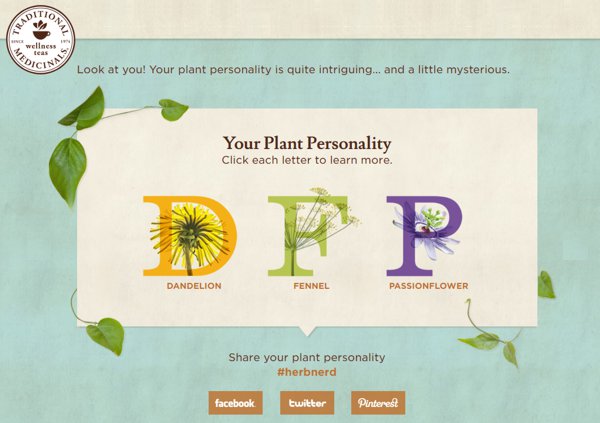 A Traditional Medicinals' Plant Personality profile example.
A Traditional Medicinals' Plant Personality profile example.
Co-founded by herbalist Rosemary Gladstar and environmentalist Drake Sadler, the company bills itself as "the pioneer of the wellness tea category in the U.S. and Canada."
Similar to the Community section on the Benzagel site, Traditional Medicinals has a large and growing section of their website which they call the Plant Power Journal. It is more than your average blog, and encompasses several segments such as DIY recipes using the company's teas, as well as a library of herbs and their uses.
As noted in point #1 above, what ties it all together and makes it work is the theme.
A content theme is not necessarily what your product or service does, but how it makes people feel. For Benzagel it is reducing stress to avoid acne breakouts. For Traditional Medicinals it is "plant power." Each of them springs from the same source, based on a simple question:
What are the shared values that draw your community together?
A simple question, yes… but it takes some deep thinking—and sometimes outside guidance—to discover A sailboat crew is a way of thinking about shared values.
A sailboat crew is a way of thinking about shared values.
and clearly define an answer that not only works for you as a marketer, but more importantly, for your extended user community.
One way to think about it is to picture your community as the crew of a sailboat.
Each person has their own role and their own perspective; but as a group they are pulling together to move forward in the same direction. That direction is the common theme your brand represents.
Once you've found it, stick with it! Your theme is what makes your brand relevant to its audience, and valuable to them. So sticking with that theme will keep you on the path to continued growth in brand value.
3. Tell a Story
If you've come this far and are still reading, maybe it's because you haven't yet seen the option that works for your brand.
I get it. Your user community is not the type that is likely to contribute content. Quizzes and surveys are fine, but there's no way YOUR product or service can be made out to be fun. (No wait… before you jump to that conclusion, talk to me, really—I don't believe there's any brand so dull you can't find a fun angle on it!)
But, lucky you, this third approach fits the bill. Believe it or not, there is a way to achieve all the benefits mentioned at the top of this article, while maintaining complete control of the process, the wording, and the visual presentation of the content on your site. The solution is to write user experience stories.
A story carries a much greater sense of authenticity.
While stories that you write yourself are not technically "user-generated," if done properly they can have the same effect of presenting what your brand offers through the eyes and experiences of the user. Rather than providing a list of product specifications and attributes, a story that tells about a customer success that was aided by your product or service carries a much greater sense of authenticity that your audience can relate to.
Start by choosing the customer(s) or community member(s) whose story and comments you want on your site. Then just ask if they'd like to be featured. If you've chosen well, and your request is respectful and thoughtful, the answer will very often be Yes.
The most common example of this user story approach is the Case Study, a go-to standard of B2B marketing. However, it can be used in any situation, and is often resorted to by marketers in regulated industries due to the high level of control it provides over the end content.
One such player in the tightly-regulated financial industry, is Fredericks Foundation of Surrey, UK. 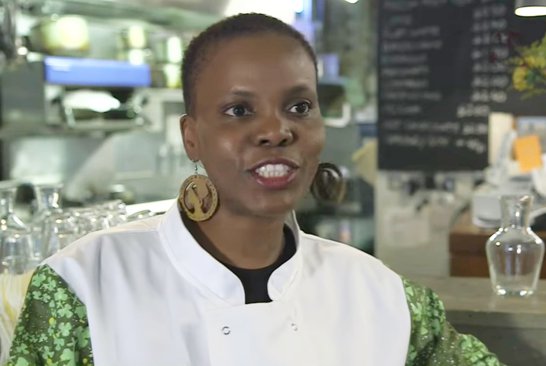 Tokunbo Koiki, founder of Tokunbo's Kitchen
Tokunbo Koiki, founder of Tokunbo's Kitchen
Fredericks provides loans to entrepreneurs who have been turned down by mainstream lenders, and also supports its clients with mentoring, networking links, and business advice.
The results of the foundation's dedication to entrepreneurship can be seen in the section of their website appropriately titled, "Inspiring Client Success Stories." As is common in this approach to user content, the stories are written as third person narratives. Although each story is carefully worded, all are true human interest stories, with a central character who has faced adversity and succeeded with the support of Fredericks.
There is the story of Tokunbo Koiki, born in London and raised in Nigeria, whose dream was to bring the experience of authentic Nigerian cuisine and culture to the country of her birth. In her words, "Tokunbo’s Kitchen is a not just a food event but an opportunity to enjoy authentic Nigerian food within an informal and social experience.”
Another story on the site tells of brothers Harry and Ben, whose upbringing on a farm taught them the value of re-purposing everything in inventive ways. Together they hatched the idea of creating furniture and decorative items from reclaimed aircraft parts.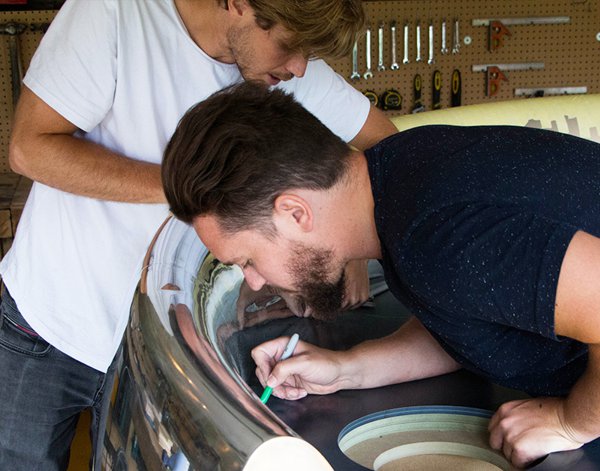 Harry and Ben, founders of Plane Industries.
Harry and Ben, founders of Plane Industries.
"Unfortunately the banks would not lend due to the brothers young age." Enter Fredericks with a small business loan, and the brothers' now thriving business, Plane Industries, was born.
These and other featured stories make the brand real and meaningful for an audience that might not otherwise feel connected to the worlds of finance, investment and entrepreneurship. They are consistent with the ethos and the shared values that have created a community around the brand.
Fredericks Founder and Chairman Paul Barry-Walsh was named the UK's 2016 Entrepreneur of the Year, awarded jointly by University College London and the Daily Telegraph Business Reporter. “I wanted to help those who did not have access to cash," he said. "I do not believe in handouts, but I do believe in helping people up and supporting them. That is what we try to do.” And that is exactly the brand vision that shines through in the stories.
At this point I'm hearing many B2B marketers saying our product or service is not really so emotionally charged—we just want an effective way to get across the business advantages our customers appreciate. No problem. There are many good examples of well-written, straightforward Business Use Cases 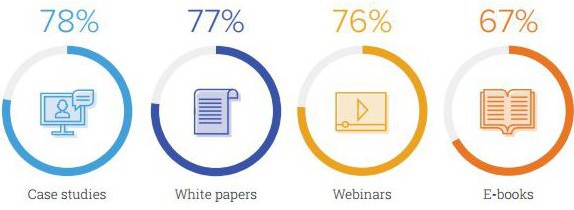 Case Studies topped the 2017 Content Preferences Survey.
Case Studies topped the 2017 Content Preferences Survey.
that get the point across with real world examples, and quotes from happy customers.
In fact, according to the 2017 DemandGen Content Preferences Survey, case studies are the top content type preferred by B2B buyers, with 78% using this format type when researching purchases, and 48% calling them the most valuable information source.
After all, businesspeople are human beings, and they like to believe the companies they deal with are human, too.
One more stumbling block for the mid-size marketer could be the difficulty of finding an end-user customer who will agree to be directly quoted. 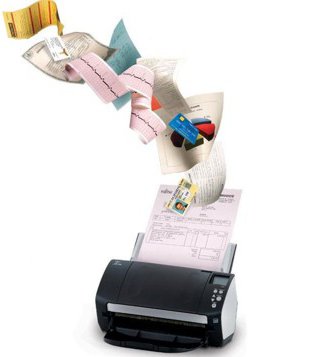 Fujitsu image scanner fi7160.
Fujitsu image scanner fi7160.
Many B2B companies sell their products indirectly, through a network of sales channel partners, and therefore may not have a direct relationship with the end customer. Even that issue can be overcome, by writing the story from the perspective of the reseller describing how well the product or solution worked for the end customer.
Good examples of this approach can be found in the extensive library of Use Cases featured on the Fujitsu Image Scanner website. In one, Fujitsu Canada reseller Polar Imaging describes a WorkFlow Management solution based on Fujitsu fi-7160 image scanners that created a huge time saving in document retrieval and compliance audits. With the new system, documents can now be found in seconds, rather than hours.
Specifics of how your product or service has been applied and the benefits it generated are what B2B buyers need in order to justify their purchases. And putting it in story form is much more persuasive than a list of bullet points.
Summary: Lessons Learned
Remember the two statistics noted at the top of this article: authentic, user generated content is both more trusted, and more memorable, than any other media your customers and clients are exposed to daily.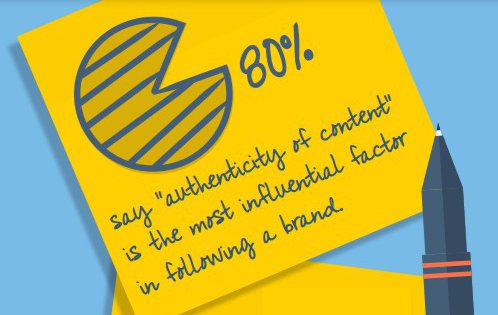 Authenticity the most influential factor: Pardot Research.
Authenticity the most influential factor: Pardot Research.
This is not a passing fad—it's human nature. The fact that consumers feel a higher level of trust and engagement with content shared with them by their peers is fundamental. Moving forward, "authenticity of content" will continue to be the most influential factor in people following your brand.
The content doesn't have to be reviews of your product or service, it just needs to be two things:
- On theme with the values consumers attach to your brand.
- Authentic. (Sorry, you can't just make this stuff up.)
 What are the shared values in your community?There's also a bigger issue here, one that has to be at the core of your marketing strategy. Your brand should mean something. Every brand represents a set of shared values that are understood and embraced within its community. It's what holds them together, and what gives the brand meaning.
What are the shared values in your community?There's also a bigger issue here, one that has to be at the core of your marketing strategy. Your brand should mean something. Every brand represents a set of shared values that are understood and embraced within its community. It's what holds them together, and what gives the brand meaning.
Discover what that is, build a theme around it, and use it to engage with your users to create authentic, relevant content. There are challenges and pitfalls in the process; but the result is well worth it.
A Caveat
I can't emphasize enough how important it is to encourage this user activity on a website you own. By far, the greatest pool of user generated content today is on social networks like Facebook, Instagram, LinkedIn… and a long list of others. Using those networks in both your paid media and earned media marketing plans goes without saying. I'm not recommending that you try to build an effective plan without them.
However, as noted recently in the web-tech publication CMS Connected, "Nearly 99% of UGC (user generated content) is owned by the social networks… at the end of the day, the social channel owns branded UGC, licensed and royalty-free, and [they also own] the metadata, which provides a deeper level of understanding of audience."
Encourage user content on your own website so you can see your visitor data.
The last point is the most troubling. As a marketing strategist, my concern is the fact that the social networks are in possession of the deep data on your audience. This has become a fact of life for mid-size marketers. Few, if any, can market effectively today without in one way or another paying for access to that data, and the audience attention the networks command.
What you can do, though, is as far as possible encourage and generate user content on your own website or blog, so you have an opportunity to see the data on your own visitors. That data is a gold mine of strategic insights for building the value of your brand.
And make sure any agency you're working with shares it with you!
Your Turn
We would love to see your examples of effective user content strategies. Tell us about any you've participated in, or know of, in the comments section below.
Or, give us your thoughts on the ones profiled in this story. We'll respond to any thoughtful comments, and definitely check out any interesting examples you provide. And if we get enough good new examples, we'll feature the best in a future post!
Sources cited in this article:
- Millennials Trust User-Generated Content 50% More Than Traditional Media
http://www.adweek.com/digital/millennials-trust-user-generated-content-50-traditional-media-infographic/ - Social Influence: Marketing's New Frontier | Get the Research Paper
http://corp.crowdtap.com/socialinfluence - Five Engagement Questions—Answered: A Pardot Research Report
https://www.pardot.com/content-marketing/5-engagement-questions-answered-pardot-research-report/ - B2B Content Marketing Report
https://www.slideshare.net/hschulze/b2b-content-marketing-report-40688285 - The 2017Content Preferences Survey Report
https://www.demandgenreport.com/resources/research/the-2017-content-preferences-survey-report

